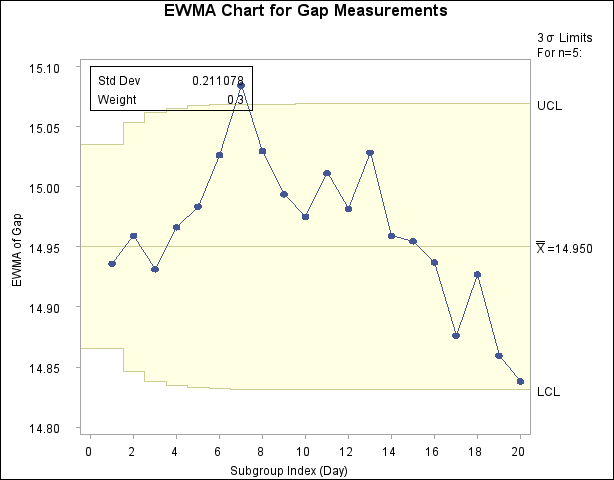| The MACONTROL Procedure |
| Getting Started |
This section introduces the INSET statement with a basic example showing how it is used. See INSET and INSET2 Statements for a complete description of the INSET statement.
This example is based on the same scenario as the first example in the "Getting Started" section of EWMACHART Statement An EWMA chart is used to analyze data from the manufacture of metal clips. The following statements create a data set containing measurements to be analyzed and the EWMA chart shown in Figure 9.7.2.
data Clips1;
input Day @ ;
do i=1 to 5;
input Gap @ ;
output;
end;
drop i;
datalines;
1 14.76 14.82 14.88 14.83 15.23
2 14.95 14.91 15.09 14.99 15.13
3 14.50 15.05 15.09 14.72 14.97
4 14.91 14.87 15.46 15.01 14.99
5 14.73 15.36 14.87 14.91 15.25
6 15.09 15.19 15.07 15.30 14.98
7 15.34 15.39 14.82 15.32 15.23
8 14.80 14.94 15.15 14.69 14.93
9 14.67 15.08 14.88 15.14 14.78
10 15.27 14.61 15.00 14.84 14.94
11 15.34 14.84 15.32 14.81 15.17
12 14.84 15.00 15.13 14.68 14.91
13 15.40 15.03 15.05 15.03 15.18
14 14.50 14.77 15.22 14.70 14.80
15 14.81 15.01 14.65 15.13 15.12
16 14.82 15.01 14.82 14.83 15.00
17 14.89 14.90 14.60 14.40 14.88
18 14.90 15.29 15.14 15.20 14.70
19 14.77 14.60 14.45 14.78 14.91
20 14.80 14.58 14.69 15.02 14.85
;
title 'EWMA Chart for Gap Measurements';
symbol v=dot;
proc macontrol data=Clips1;
ewmachart Gap*Day / weight = 0.3
nolegend;
inset stddev weight;
run;
Output 9.7.2
Exponentially Weighted Moving Average Chart with an Inset

Copyright © SAS Institute, Inc. All Rights Reserved.